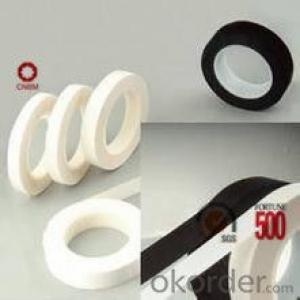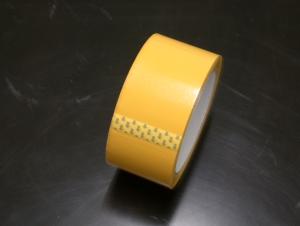Duct Water Base BOPP Packing Tape BP-8
- Loading Port:
- China Main Port
- Payment Terms:
- TT OR LC
- Min Order Qty:
- -
- Supply Capability:
- -
OKorder Service Pledge
OKorder Financial Service
You Might Also Like
Product Description:
Quick details:
· Material: BOPP
· Use: Carton Sealing
· Adhesive Side: Single Sided
· Adhesive: Acrylic
· Adhesive Type: Water Activated
· Design Printing: Offer Printing
· Place of Origin: China (Mainland)
· color: clear, super clear, crystal clear, red, blue, brown, yellow, green etc
Specifications:
ItemNo. | Carrier | Adhesive | Total | Initial | Peel Adhesion | Holding | Tensile | Elongation |
BP-40 | BOPP film | water based acrylic | 40 micron | >18# | 0.5kgf/25mm | >24h | >30N/cm | <180% |
BP-45 | BOPP film | water based acrylic | 45 micron | >18# | 0.5kgf/25mm | >24h | >30N/cm | <180% |
BP-50 | BOPP film | water based acrylic | 50 micron | >20# | 0.5kgf/25mm | >24h | >30N/cm | <180% |
BP-65 | BOPP film | water based acrylic | 65 micron | >24# | 7.88N/25mm | >40h | >30N/cm | <180% |
Application:
Bopp tape is mainly for Carton sealing & packing, Light duty packaging, bundling, holding, and other office & household use.
Packing:
Paper Core ID: 76mm
Jumbo size: 1280mm x 4000m; 1625mm x 4000m
Cut roll size: As per customer's requirement
Cut rolls: 6 rolls per shrink, 36/54/72 rolls per carton with or without pallet
Jumbo rolls & log rolls: Packed with kraft paper and stretch wrap film, with or without pallet
- Q: How do I remove packaging tape without damaging the surface?
- To ensure the surface remains undamaged, adhere to these steps for removing packaging tape: 1. Commence by gently heating the tape with a hairdryer set on low. The heat will cause the adhesive to soften, facilitating easier removal. 2. Employ your fingernail or a plastic scraper to delicately lift one corner of the tape. Exercise caution to avoid employing sharp objects that might leave scratches on the surface. 3. Gradually peel the tape back at a 180-degree angle, applying consistent and uniform pressure. If the tape proves resistant, pause and subject it to additional heat to further soften the adhesive. 4. In the event any residue remains, employ rubbing alcohol or a mild adhesive remover. Apply a small amount to a soft cloth and gently rub the residue until it lifts away. 5. Once the tape and residue have been eliminated, cleanse the surface with a mild soap and water solution to eliminate any remaining adhesive or residue. Always remember to test any cleaning solution on a small, inconspicuous area beforehand to ensure it does not cause damage to the surface.
- Q: How much weight can packaging tape hold?
- The weight that packaging tape can hold depends on various factors such as the type and quality of the tape, the surface it is applied to, and how it is used. Generally, packaging tapes can typically hold up to 20-30 pounds of weight, but it is always recommended to check the specific guidelines provided by the manufacturer for optimal usage.
- Q: What are the different types of packaging tape?
- There are several different types of packaging tape available for various packaging needs. 1. Clear Packaging Tape: This is the most common type of packaging tape, typically made from polypropylene or acrylic materials. It is transparent, allowing for easy visibility of labels or printed information on the package. Clear packaging tape is versatile and suitable for most general packaging applications. 2. Brown Packaging Tape: Also known as brown packing tape or brown carton sealing tape, this type of tape is made from strong, durable materials such as polypropylene or paper. It is commonly used for sealing cardboard boxes or packages, providing a secure and tamper-evident seal. Brown packaging tape is ideal for shipping and general packaging purposes. 3. Masking Tape: While not specifically designed for packaging, masking tape can be used for light-duty packaging tasks. It is made from a thin and easily tearable paper and is commonly used for holding, bundling, or labeling packages. However, masking tape may not provide the same level of strength and security as dedicated packaging tapes. 4. Duct Tape: Similar to masking tape, duct tape is not primarily designed for packaging purposes but can be used in certain situations. It is a strong and durable tape, typically made from cloth or reinforced with fibers, and is known for its adhesive strength and versatility. Duct tape can be used for heavy-duty packaging tasks or for securing packages in challenging environments. 5. Specialty Packaging Tapes: There are various specialty packaging tapes available to cater to specific needs. Some examples include fragile tape, which has a warning message to indicate delicate items inside the package, or double-sided tape, which allows for secure attachment of items or joining of materials. Additionally, there are tapes designed for specific industries, such as freezer tape for sealing packages in cold storage or electrical tape for insulating electrical wires during packaging. Overall, the choice of packaging tape depends on the specific requirements of the packaging task, including the type of materials being sealed, the desired level of security, and any specific conditions or considerations.
- Q: Can packaging tape be used for sealing wooden crates?
- Yes, packaging tape can be used for sealing wooden crates. It provides a strong and secure bond, ensuring that the crate remains sealed during transportation or storage. Packaging tape is designed to adhere to various surfaces, including wood, making it an effective choice for sealing wooden crates. However, it is important to consider the weight and size of the crate before solely relying on packaging tape. For heavier or larger crates, it may be necessary to reinforce the seal with additional methods such as nails or screws.
- Q: Can packaging tape be used for sealing packages with automotive parts or accessories?
- Yes, packaging tape can be used for sealing packages with automotive parts or accessories. Packaging tape is designed to securely seal packages, and it can effectively hold together packages containing automotive parts or accessories. It provides a strong adhesive bond, ensuring that the package remains sealed during transportation or storage. Additionally, packaging tape is often resistant to moisture, which is important when shipping automotive parts or accessories that may be sensitive to water damage.
- Q: A tape of 2.5 cm thick, about how many meters
- The average Taobao buys tapes between 165 and 170 meters. Actually do look at the film thickness. Less film thickness and less rice. The membrane is thin and the rice is more
- Q: How does packaging tape perform on recycled or eco-friendly packaging materials?
- When it comes to recycled or eco-friendly packaging materials, packaging tape tends to perform well. The performance of the tape, however, will ultimately depend on the specific type of material being used. Recycled packaging materials, like cardboard or paper, typically have a rougher surface than traditional packaging materials. Nevertheless, packaging tape is specifically designed to stick to various surfaces, even those with different textures. As a result, it should adhere well to recycled materials without any major issues. Eco-friendly packaging materials, such as biodegradable or compostable plastics, may possess slightly different properties in comparison to traditional plastics. Nonetheless, most packaging tapes are designed to work effectively with different types of plastics, including eco-friendly options. It is crucial to ensure that the packaging tape you select is compatible with the specific eco-friendly material you are utilizing. In general, packaging tape is created to provide a secure and reliable seal on packaging materials, regardless of whether they are recycled or eco-friendly. However, it is always advisable to test the tape on a small area of the material prior to applying it to the entire package. This will help ensure proper adhesion and compatibility.
- Q: Are there any safety precautions to consider when using packaging tape?
- There are various safety measures to take into account when utilizing packaging tape. To begin with, it is vital to work in a well-ventilated area to avoid inhaling excessive adhesive fumes, which can be harmful. Furthermore, it is crucial to handle the tape dispenser cautiously to prevent any injuries. Ensure that your hand placement is correct and avoid placing your fingers too close to the cutting blade to avoid unintended cuts. Moreover, it is advisable to wear appropriate protective gear, such as gloves, when using packaging tape to shield your hands from potential adhesive residue or cuts. Finally, it is essential to store the tape in a safe and secure location, out of reach of children or pets, to prevent accidental ingestion or misuse. By adhering to these safety measures, you can guarantee a secure and effective utilization of packaging tape.
- Q: Is packaging tape safe to use on painted surfaces?
- Packaging tape is generally considered safe for use on painted surfaces, but there are a few factors that need to be taken into account. Firstly, it is crucial to make sure that the paint has completely dried before applying any tape. This usually takes about 30 days, depending on the type of paint used. Applying tape to fresh or wet paint can result in damage when the tape is removed. Secondly, the type of tape utilized can also impact the outcome. Most packaging tapes are designed to be easily removable without leaving any residue or causing harm to surfaces. However, there are some low-quality tapes or those with strong adhesives that may leave sticky residue or even strip off the paint upon removal. It is advisable to opt for high-quality packaging tape that is explicitly labeled as safe for painted surfaces. To err on the side of caution, it is always wise to conduct a test on a small and inconspicuous area of the painted surface before applying the tape extensively. This will help ensure that the tape does not cause any damage or leave any residue behind. If there are any concerns, it is recommended to consult the manufacturer's instructions or seek professional advice. In conclusion, when used correctly and on fully dried paint, packaging tape should be safe for use on painted surfaces. However, it is vital to exercise caution and select the appropriate tape to prevent any potential damage.
- Q: How does packaging tape perform in high-pressure conditions?
- Packaging tape is designed to perform well in high-pressure conditions. It is typically made from strong and durable materials such as polypropylene or polyester, which can withstand pressure, tension, and stress. These tapes have excellent adhesive properties that enable them to bond securely with various surfaces, even under high pressure. Additionally, packaging tapes are often equipped with features like reinforced fibers or water-activated adhesives, which further enhance their performance in demanding conditions. Overall, packaging tape is reliable and effective for sealing and securing packages, even in high-pressure environments.
Send your message to us
Duct Water Base BOPP Packing Tape BP-8
- Loading Port:
- China Main Port
- Payment Terms:
- TT OR LC
- Min Order Qty:
- -
- Supply Capability:
- -
OKorder Service Pledge
OKorder Financial Service
Similar products
Hot products
Hot Searches
Related keywords


























